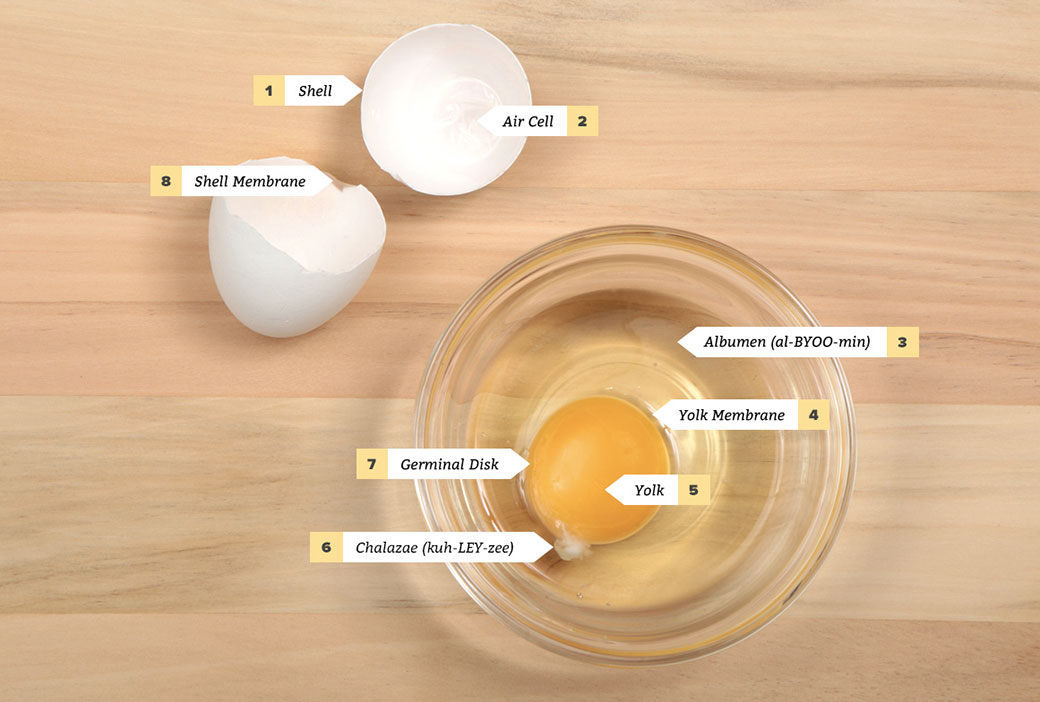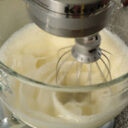All About the Egg

Anatomy of the Egg
Have you ever wondered what that white stringy bit attached to the yolk is called or what albumen is? Here is everything you ever wanted to know about the anatomy of an egg and probably a little bit more!

- Shell: The egg’s first line of defence against the entry of bacteria. Can be white or brown, depending on the breed of hen; the nutritional value of the egg is the same. Approximately 10,000 tiny pores allow moisture and gases in and out.
- Air Cell: Formed at the wide end of the egg as it cools after being laid. The fresher the egg, the smaller the air cell.
- Albumen (al-BYOO-min): Albumen is the egg white and represents 2/3 of an egg’s weight. There are two layers: thick and thin albumen. Mostly made of water, high-quality protein and minerals.
- Yolk Membrane (vitelline membrane): Surrounds and holds the yolk. The fresher the egg, the stronger the membrane.
- Yolk: The egg’s major source of vitamins and minerals and represents 1/3 of an egg’s weight. Colour ranges from light yellow to deep orange, depending on the hen’s feed. The colour of the yolk does not affect the egg nutritional value.
- Chalazae (kuh-LEY-zee): A pair of spiral bands that anchor the yolk in the centre of the thick albumen. The fresher the egg, the more prominent the chalazae.
- Germinal Disk: Appears as a slight depression on the surface of the yolk. The entry for the fertilization of the egg.
- Shell Membrane: The egg’s second line of defence against bacteria. There are two membranes on the inside of the shell: one sticks to the shell and the other surrounds the albumen.
Nutrition facts
Two large (105g) Grade A eggs contain 13g of protein and only 160 calories. Canada’s Food Guide considers eggs to be a valuable source of high-quality protein.
Nutritional Information per 105g serving:
| Calories | 160 Cal |
| Fat | 11 g |
| Cholesterol | 400 mg |
| Sodium | 130 mg |
| Carbohydrate | 1 g |
| Protein | 13 g |
The vitamins and minerals of an egg and how they benefit you:
| NUTRIENT | BENEFIT |
|---|---|
| Iron | Carries oxygen to the cells, helps prevent anemia |
| Vitamin A | Helps maintain healthy skin and eye tissue; assists in night vision |
| Vitamin D | Strengthens bones and teeth; may help protect against certain cancers and auto-immune diseases |
| Vitamin E | An antioxidant that plays a role in maintaining good health and preventing disease |
| Vitamin B12 | Helps protect against heart disease |
| Folate | Helps produce and maintain new cells; helps prevent a type of anemia, helps protect against serious birth defects if taken prior to pregnancy and during the first 3 months of pregnancy |
| Protein | Essential for building and repairing muscles, organs, skin, hair and other body tissues; needed to produce hormones, enzymes and antibodies; the protein in eggs is easily absorbed by the body |
| Selenium | Works with vitamin E to act as an antioxidant to help prevent the breakdown of body tissues |
| Lutein and zeaxanthin | Maintains good vision; may help reduce the risk of age-related eye diseases, such as cataracts and macular degeneration |
| Choline | Plays a strong role in brain development and function |
What’s the difference between brown and white eggs?
Aside from the colour of the eggshell, there is little difference between brown and white eggs. The eggshell colour depends on the breed of the hen. Generally speaking, white shell eggs come from hens with white feathers, while brown shell eggs are produced by hens with brown feathers. Nutritionally, both brown and white eggs are identical unless the feed has been enhanced.
Small Medium Large: What size eggs should I use?

You may have noticed that the eggs in your grocery store come in a variety of sizes ranging from peewee to jumbo. In Canada, all Grade A eggs are categorized by weight, not size or shape, so sometimes eggs in the same carton may appear to be different sizes, but their weight will always be within a similar range.
The following minimum weights are used to classify eggs in Canada:
What the sizes mean:
- Peewee – less than 42 grams
- Small – at least 42 grams
- Medium – at least 49 grams
- Large – at least 56 grams
- Extra Large – at least 63 grams
- Jumbo – 70 grams or more
Unless otherwise specified, more recipes are written using large eggs. Generally, medium and extra large eggs can be used instead of large eggs for recipes, unless you’re working with whipped egg whites. Everyday dishes can substitute 1:1, but for baking purposes, use the following conversions:
Egg Size Substitutions
Most recipes are written using large eggs. To substitute another size, follow this chart:
| Small | Medium | Extra Large | |
|---|---|---|---|
| 1 egg | 2 | 1 | 1 |
| 2 eggs | 3 | 2 | 2 |
| 3 eggs | 4 | 4 | 3 |
| 4 eggs | 6 | 5 | 3 |
| 5 eggs | 7 | 6 | 4 |
| 6 eggs | 8 | 7 | 5 |
How Do Eggs Measure Up?



